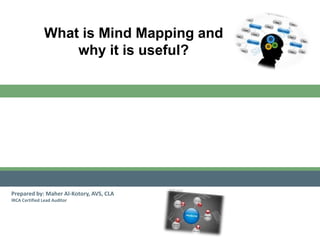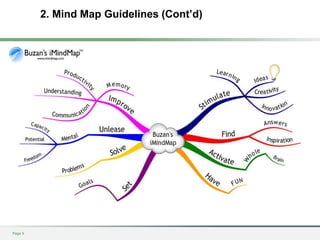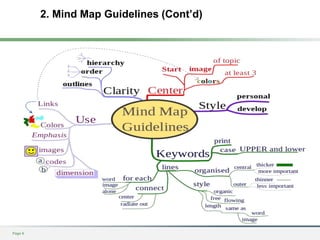Assignment10-Mind_Mapping.ppt
- 1. Prepared by: Maher Al-Kotory, AVS, CLA IRCA Certified Lead Auditor What is Mind Mapping and why it is useful?
- 2. Discussion Points Page 2 1. What is Mind Mapping? 2. Mind Map Guidelines 3. Benefits of using Mind Mapping 4. What is the difference between Brainstorming and Mind Mapping? 5. When Can We use Mind Map? 6. Example of Mind Mapping 7. Videos of Mind Mapping 8. Links to Mind Mapping Software 9. Further readings 10.Questions
- 3. 1. What is Mind Mapping? ’é¦ A mind map is a graphical way to represent ideas and concepts. ’é¦ It is a visual thinking tool that helps structuring information, helping you to better analyze, comprehend, synthesize, recall and generate new ideas. Just as in every great idea, its power lies in its simplicity. ’é¦ A mind map is often created around a single concept. ’é¦ A mind map is a visual representation of hierarchical information that includes a central idea surrounded by connected branches of associated topics. ’é¦ Mind mapping is a visual form of note taking that offers an overview of a topic and its complex information, allowing students to comprehend, create new ideas and build connections. Page 3
- 4. 2. Mind Map Guidelines Buzan suggests the following guidelines for creating mind maps: ’é¦ Start in the center with an image of the topic, using at least 3 colors. ’é¦ Use images, symbols, codes, and dimensions throughout your mind map. ’é¦ Select key words and print using upper or lower case letters. ’é¦ Each word/image is best alone and sitting on its own line. ’é¦ The lines should be connected, starting from the central image. The lines become thinner as they radiate out from the center. ’é¦ Make the lines the same length as the word/image they support. ’é¦ Use multiple colors throughout the mind map, for visual stimulation and also for encoding or grouping. ’é¦ Develop your own personal style of mind mapping. ’é¦ Keep the mind map clear by using radial hierarchy or outlines to embrace your branches. Page 4
- 5. 2. Mind Map Guidelines (ContŌĆÖd) Page 5
- 6. 2. Mind Map Guidelines (ContŌĆÖd) Page 6
- 7. 2. Mind Map Guidelines (ContŌĆÖd) Page 7
- 8. 3. Benefits of using Mind Mapping. ’é¦ Note taking ’é¦ Problem solving ’é¦ Planning ’é¦ Researching and consolidating information from multiple sources ’é¦ Presenting information ’é¦ Gaining insight on complex subjects ’é¦ Jogging your creativity Page 8
- 9. 4. What is the difference between Brainstorming and Mind Mapping? ’é¦ Brainstorming is a way to expand your thinking on a topic. ’é¦ Mind mapping then helps you to organise your ideas and consider the relationships between them. These techniques may assist you to: ’é¦ focus your research ’é¦ solve problems ’é¦ develop a structure for an assignment ’é¦ There are two stages in the process: a free thinking stage and an organising stage ŌĆō these should not be done together. Page 9
- 10. 4. What is the difference between Brainstorming and Mind Mapping? (ContŌĆÖd) Stage 1: brainstorming = free thinking producing ideas ’é¦ 1. Write your topic or area of study in the center of a blank page. ’é¦ 2. Use colors, pictures, words and symbols to record any other ideas, topics, authors, theories or anything else associated with the topic. You can put these anywhere on the page. Associate freely and do not filter out ideas; at this point anything and everything is potentially useful. Page 10
- 11. 4. What is the difference between Brainstorming and Mind Mapping? (ContŌĆÖd) Stage 2: mind mapping = identifying relationships organizing ideas 1. Circle the key points or ideas you have identified. 2. Identify gaps in your knowledge, and any questions you have. 3. Look at each item and consider, ŌĆ£How does this point relate to the others, and to the topic as a whole?ŌĆØ 4. Map the relationships between the ideas or key points using lines, arrows, colors and words to link them. 5. Identify the type of relationship between points: contrast / similarity / cause / effect (see over). Write these along the linking lines. 6. Use this map to plan/guide your assignment: arrange items in a logical order to create the structure of your assignment. Page 11
- 12. 5. When Can We use Mind Map? Page 12
- 13. 5. When Can We use Mind Map? (ContŌĆÖd) Page 13
- 14. 6. Examples of Mind Mapping Page 14
- 15. 6. Examples of Mind Mapping (ContŌĆÖd) Page 15
- 16. 6. Examples of Mind Mapping (ContŌĆÖd) Page 16
- 17. 6. Examples of Mind Mapping (ContŌĆÖd) Page 17
- 18. 6.Examples of Mind Mapping (ContŌĆÖd) Page 18
- 19. 6.Examples of Mind Mapping (ContŌĆÖd) Page 19
- 20. 6.Examples of Mind Mapping (ContŌĆÖd) Page 20
- 21. 7. Videos of Mind Mapping. Project Planning using Mind Mapping http://www.youtube.com/watch?v=_ERcknXoT1o ŌĆ½ž¦┘äž░┘ć┘å┘Ŗž®ŌĆ¼ ŌĆ½ž¦┘äž«ž▒ž¦ž”žĘŌĆ¼ ( ŌĆ½ž¦žŻ┘ä┘ł┘äŌĆ¼ ŌĆ½ž¦┘äž¼ž▓žĪŌĆ¼ ) http://www.youtube.com/watch?v=xREVtx0Yi- o&list=PL6D77513C439EC18A Page 21
- 22. 8. Links to Mind Mapping Software ’é¦ http://www.xmind.net/ ’é¦ http://cmap.ihmc.us/conceptmap.html Page 22
- 23. 9. Further Readings Page 23























